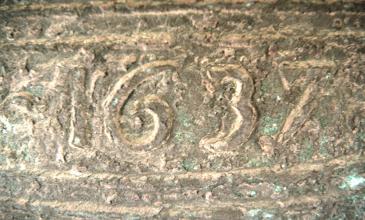The first known sundial at the present location in Old Court was erected May–July 1642, when entries in the college accounts show payments for stone, gilt, painting, etc. (see below).
There are references in the college accounts of 1538 [Magnum Journale 1537–8, f. 42b, quoted AHUC II, p. 50] for the creation of an earlier sundial on the chapel bell-tower: we have no evidence as to the appearance of that sundial, or its eventual fate: it was supplanted at an unknown date by a clock (the clock which is referred to in the accounts as being repaired in 1733). The chapel bell-tower was demolished in 1804.
It is to be noted that the bell of the clock in the chapel bell-tower was cast in 1637: we may surmise that the present sundial might have been erected because of the need to set a clock, or perhaps that the introduction of a clock in the bell-tower meant that a sundial previously on the tower had to be displaced downwards.The present dial was originally painted onto flat blocks of stone set into the brick wall. The original accounts for erecting the dial in May–July 1642 are: [Magnum Journale 1641–2, ff. 102b–103, quoted AHUC II, p. 51]
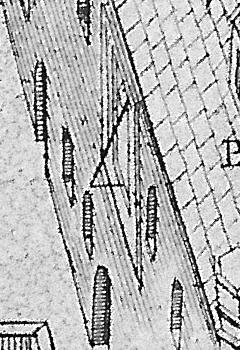 The gnomon and square background of the dial are just visible in outline in Loggan’s view of 1685: this disproves the date of 1733 for the dial quoted by some histories and guide-books.
The gnomon and square background of the dial are just visible in outline in Loggan’s view of 1685: this disproves the date of 1733 for the dial quoted by some histories and guide-books.
The antiquary Cole recorded, probably in 1742:
Over ye W. end [of the Chapel] is a small tower and agst ye side of it wch fronts ye Court is lately placed a very handsome Clock, 1733, and directly under it on ye Wall of ye Chapel and over ye Door wch leads to it is also lately painted a very elegant Sun Dial with all ye signs. This is no small ornamt to ye Court to enliven it.
[MSS Cole, quoted AHUC II, p. 51]
Strictly, Cole’s date of 1733 relates to the clock, not the dial, but there is an inference that the dial is of a similar vintage to the clock. It is not clear from Cole’s account whether the dial design was new when he saw it, or merely an older design freshly repainted. It is from this reference that all false reports of 1733 for the date of the dial are descended. The following entries in the college accounts might relate to Cole’s observations: [Magnum Journale 1732–33]
These works were contemporary with the remodelling of the dining hall, designed by James Burrough, so they might have formed part of a general campaign to smarten up the college.
Carter’s History of 1753 records:
The Sundial, on the North side of the principal Court, and under the Clock-Dial, is counted a Curiosity, being beautifully ornamented with a variety of useful Furniture, the whole being the work of the great Sir Isaac Newton.
[The History of the University of Cambridge, by Edmund Carter, 1753, p. 186]
Carter’s attribution is reproduced without question in later histories throughout the 19th century, for instance:
The eastern court contains nothing remarkable, except it may be the dial on the north side, as being curiously ornamented, and the invention of Sir Isaac Newton.
[The History of the University and Colleges of Cambridge, by George Dyer, 1814, vol. 2, p. 161]
However, as a historian, Carter was not renowned for accuracy, and we cannot place much weight on his attribution [Dyer’s History, 1814, vol. 1, pp. 22–3: never was printed a more inaccurate book
, so full of blunders and inaccuracies, as to be altogether unaccountable
; Huber’s The English Universities (tr. Newman), vol. 2, part 2, pp. 588–9: Carter’s History categorised as worthless
]. The College in fact has no evidence as to who designed the sundial. Newton cannot have designed a dial in 1642, for he was then not yet born, and he cannot have designed a dial around 1733, for he was by then dead. Newton is not known to have designed any sundial in Cambridge.
In any case, we have the dial of Nikolai Kirke, Copenhagen, to demonstrate that dials of similar design were not unknown in the early to mid-17th century: the design of the Queen’s sundial would not be out of place for a date of 1642.
The dial is known, from college records, to have been repainted in:
- 1685
- 1733 by Jo: Sharp
- 1775 May [Conclusion Book]
- 1864 by F.R. Leach
- 1911 by F.R. Leach & Sons
- 1928 by W. Perry Leach
- 1948 by Rattee & Kett
- 1968 by Bertram Winterton (1904–1985) Fellow of the Institute of British Decorators and Interior Designers
- 1971 by Bertram Winterton
- 1998 (moon table only) by college staff
Dimensions
The dial is not a perfect rectangle, but the mean dimensions (measured to the outer edge of the blue chapter ring and not including the variable border) are, in pre-metric British units: width 8 feet (8′ 0″), and height 7 feet 8 inches (7′ 8″), not including the moon table. The nodus height (perpendicular distance of the ball from the flat surface of the dial) is 1 foot 3 inches (1′ 3″), and the diameter of the nodus ball is around 1¾ inches.
Images
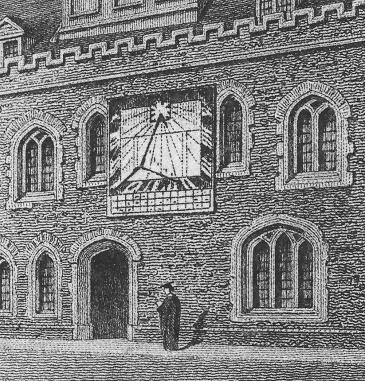 The earliest recognisable depiction of the decoration of the sundial is shown in the view of the court engraved by Storer in 1829.
The earliest recognisable depiction of the decoration of the sundial is shown in the view of the court engraved by Storer in 1829.
This is an enlarged detail of the dial.
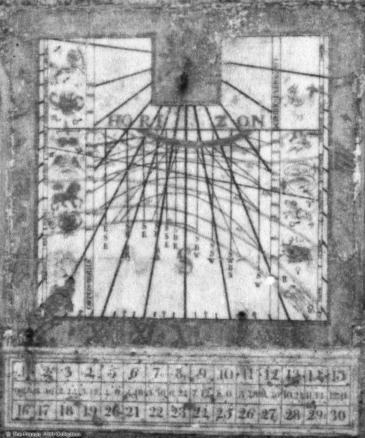 For some period in the mid-19th century the sundial was useless, having no gnomon. This photo, highly enlarged from a view of the court taken around 1860–4, shows the dial in this state.
For some period in the mid-19th century the sundial was useless, having no gnomon. This photo, highly enlarged from a view of the court taken around 1860–4, shows the dial in this state.
The moon-table is shown with a significantly different style of lettering than that used in later re-paintings.
The column which today is headed LONGITUDO can be seen to have then read LONGITUDO DIERUM: length of days. It is possible also that the Months columns are labelled, but the photograph is not sufficiently clear to make them out.
Various temporary hour lines and elevation curves are shown to be truncated at the right on the vertical line for the SW compass bearing, rather than continuing to the frame: this was not put right until 1948.
On the left-hand side, there is no clear distinction between the Unequal Hour 1 line, and the 10° elevation curve, and it is possible that only the former is present.
This photograph is Copyright © The Francis Frith Collection, reproduced here by permission.
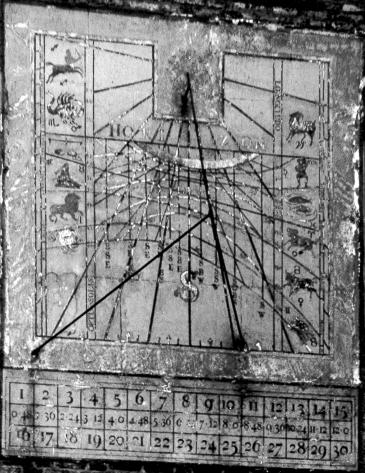 The gnomon was later restored (probably during the 1864 repainting). However, the ball, whose shadow is essential for reading anything other than the simple time of day, was not restored to the gnomon: this 1897 photograph is typical of the dial in that state. The decoration of 1864 can be seen to be already deteriorating.
The gnomon was later restored (probably during the 1864 repainting). However, the ball, whose shadow is essential for reading anything other than the simple time of day, was not restored to the gnomon: this 1897 photograph is typical of the dial in that state. The decoration of 1864 can be seen to be already deteriorating.
The gnomon remained without a ball until the repainting of 1911
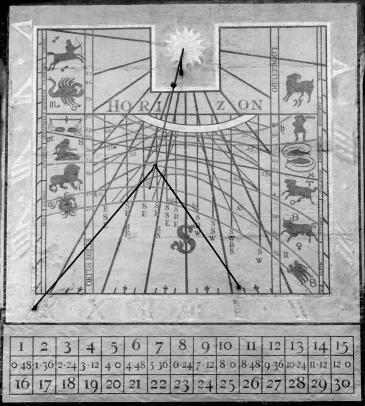 This photograph shows the state of the dial shortly after its 1911 repainting. This work was probably a late phase of the general restoration of the north wing of Old Court undertaken in 1910, when the Brandon clock-tower of 1848 was removed, the present clock-tower erected, the roof changed from slates to tiles, and the battlements of 1819 were removed.
This photograph shows the state of the dial shortly after its 1911 repainting. This work was probably a late phase of the general restoration of the north wing of Old Court undertaken in 1910, when the Brandon clock-tower of 1848 was removed, the present clock-tower erected, the roof changed from slates to tiles, and the battlements of 1819 were removed.
It can be seen that the ball has been restored to the gnomon, but at the wrong height: it should have been level with the horizon line.
On the left-hand side, the Unequal Hour 1 line has been mis-labelled as if it were the 10° elevation curve: a mistake that remains today.
Apparently, it took three attempts to get the right shade of blue in the border: the first was too pale, the second was too dark, and the third survived. This caused much comment from the student community, who called the final shade Bletchley blue, Bletchley being, at that time, a railway junction on the route between Cambridge and Oxford, and thus, a shade of blue between light blue and dark blue.
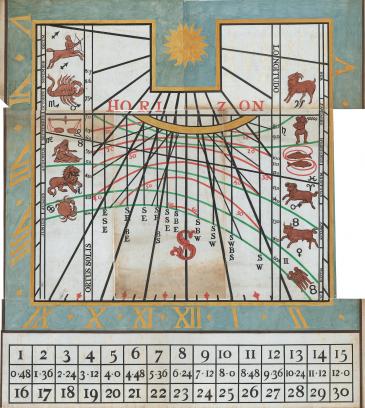 This is a composite image of tracings of the Dial, which appear to record its condition as it was in 1911 (apart from the detail of which parts of the large ‘S’ were entwined behind the 12 o’clock line). The tracings were originally made in pencilled outline, then painted in with colour. It is not known whether the tracings served as a prototype for the 1911 re-painting, or whether they were traced after the 1911 re-painting as a record.
This is a composite image of tracings of the Dial, which appear to record its condition as it was in 1911 (apart from the detail of which parts of the large ‘S’ were entwined behind the 12 o’clock line). The tracings were originally made in pencilled outline, then painted in with colour. It is not known whether the tracings served as a prototype for the 1911 re-painting, or whether they were traced after the 1911 re-painting as a record.
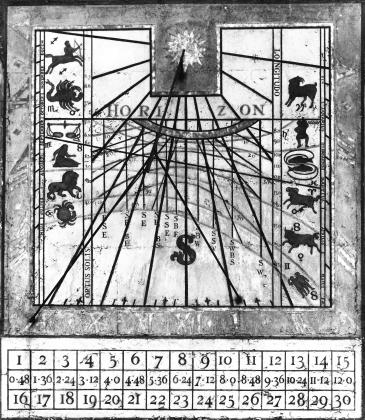
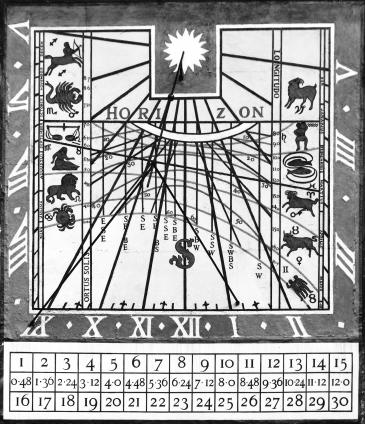 The Dial shown both before (left) and after (right) the 1948 repainting. This work was probably part of the quincentenary celebrations. By then, the gnomon had once again lost the ball necessary for advanced readings.
The Dial shown both before (left) and after (right) the 1948 repainting. This work was probably part of the quincentenary celebrations. By then, the gnomon had once again lost the ball necessary for advanced readings.
After the repainting, it can be seen that:
— the ball has been restored to the gnomon, at its correct height;
— the missing quarter-hour markers at 9:45 and 2:15 have been restored;
— the zodiac symbols for Taurus (previously a closed 8) and Libra have been corrected;
— several elevation curves and temporary hour lines which had formerly been incorrectly truncated at the vertical SW compass-bearing line were extended to the frame;
— at the bottom of the LONGITUDO column, near Gemini, the corrupt figures 6:34 have been changed to 16:30;
— the central large S is completely in the foreground, where previously its top and bottom tails had been entwined behind the 12 o’clock line.
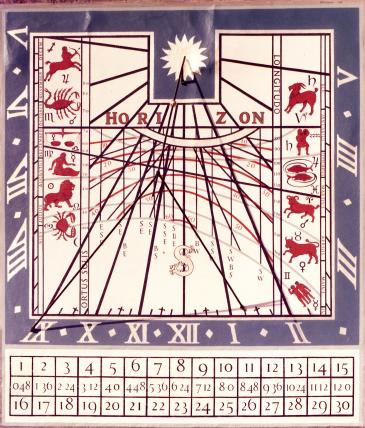 This photograph shows the dial in late 1968, after the redecoration earlier that year. The time is 2pm solar time, and the date is roughly one month after the autumnal equinox, judged by the shadow of the ball.
This photograph shows the dial in late 1968, after the redecoration earlier that year. The time is 2pm solar time, and the date is roughly one month after the autumnal equinox, judged by the shadow of the ball.
The stone backing had been found to be unreliable as a surface on which to paint the dial, as flaking of the stone led to complete loss of the painted layer. So the stone was lined with a cement render over the entire area of the dial (but not the moon-table), and the paint applied to the cement. No thought was given to the fact that moving the painted pattern closer to the ball on the gnomon ought to have required a complete recalculation of the pattern of the dial, which needed to be reduced in scale by a small amount. But this omission was slight in impact compared with a much more serious error, which is obvious when comparing this photograph with the earlier ones: the vertical 12 o’clock line ought properly to align with the virtual intersection of the gnomon line with the plane of the dial’s surface, and does so in earlier versions. But in the 1968 version, the vertical 12 o’clock line aligns with the strut holding the gnomon in position: a meaningless position in terms of the dial’s function. The result is that the entire dial pattern is painted a few inches too far to the left, and so the dial will always give a solar time which is fast
compared with actual.
Other errors included:
— Leo has ony one front leg;
— the bottom figure of the LONGITUDO column was omitted: this should have been 16:30: the length of daylight at midsummer;
— the omission of colons between the hours and minutes in the LONGITUDO column.
Corrections made included:
— two figures in the ORTUS SOLIS column were corrected: 8:6 changed to 8:0 and 8:7 to 8:30.
— Various zodiacal symbols which had become corrupt or had been lost over the years were restored. The scheme is that each zodiac point displays two symbols: that of the zodiac itself, and that of the planet traditionally associated with that zodiac. The ancients knew only of seven moving objects in the sky: the Sun, Moon, Mercury, Venus, Mars, Jupiter and Saturn. The scheme for associating seven objects with twelve zodiacs is that the true planets appear twice, and the Sun and Moon once each. The complete scheme is as follows:
| Zodiac | Aries | Taurus | Gemini | Cancer | Leo | Virgo | Libra | Scorpio | Sagittarius | Capricorn | Aquarius | Pisces |
|---|---|---|---|---|---|---|---|---|---|---|---|---|
| Symbol | ♈︎ | ♉︎ | ♊︎ | ♋︎ | ♌︎ | ♍︎ | ♎︎ | ♏︎ | ♐︎ | ♑︎ | ♒︎ | ♓︎ |
| Picture on dial |
||||||||||||
| Informal | Ram | Bull | Twins | Crab | Lion | Maiden | Scales | Scorpion | Archer | Goat | Water-bearer | Fish |
| Ruling planet |
Mars ♂ |
Venus ♀ |
Mercury ☿ |
Moon ☽ |
Sun ☉ |
Mercury ☿ |
Venus ♀ |
Mars ♂ |
Jupiter ♃ |
Saturn ♄ |
Saturn ♄ |
Jupiter ♃ |
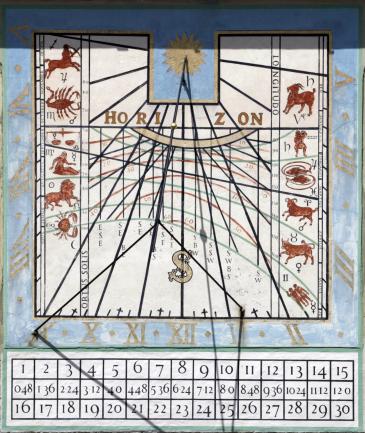 The 1968 cement rendering failed very quickly (as can be seen at the top of the 1968 photograph), and the dial had to be completely scrapped, rendered again, and painted afresh in 1971. This photograph was taken in 2006, at midsummer, with some effort taken to get the camera level with the horizon line and the golden ball. At midsummer, the roof guttering casts a shadow on the top of the dial, as can be seen.
The 1968 cement rendering failed very quickly (as can be seen at the top of the 1968 photograph), and the dial had to be completely scrapped, rendered again, and painted afresh in 1971. This photograph was taken in 2006, at midsummer, with some effort taken to get the camera level with the horizon line and the golden ball. At midsummer, the roof guttering casts a shadow on the top of the dial, as can be seen.
In the 1971 painting, Leo’s missing front leg was restored, but the other 1968 errors remain.
The table of numbers for the moondial was never rendered, and the paint there subsequently failed to adhere to the backing stone, requiring redecoration in 1998.
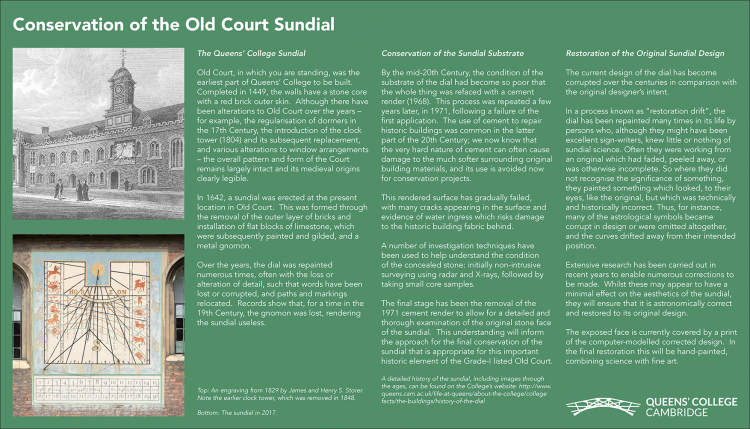 In the early 2000s, it became apparent that the cement render from 1971 was not going to last much longer as a substrate for the painted dial: planning started to remove the render, and replace the unsatisfactory stone underneath. It was hoped that a new stone backing would provide a long-term solution for the painted dial.
In the early 2000s, it became apparent that the cement render from 1971 was not going to last much longer as a substrate for the painted dial: planning started to remove the render, and replace the unsatisfactory stone underneath. It was hoped that a new stone backing would provide a long-term solution for the painted dial.
In 2019, after hacking off some of the render (necessarily destroying the painted dial) in order to examine the state of the stone underneath, the dial was replaced with a printed graphic of what the dial ought to look like, but without a gnomon. It had been planned to replace the stonework in 2020, but that was delayed by the COVID-19 pandemic.
In 2023, the old stone backing was hacked off, and a new stone backing laid, of Ancaster Weatherbed stone. This then needed to be left to weather in for a year before painting could be contemplated.
Literature review
Apart from passing references in histories and guide-books, there seem to have been no early attempts to recount the history of the dial, or to explain how to read it. Carter’s History of 1753 mentions the dial as a Curiosity
, but mis-attributes it to Newton, and provides no factual information. Searle’s History of 1867–71 was more concerned with other matters in 1642, and does not mention the account-book entries for the chapel dial. Willis & Clark, in their Architectural History of 1886, were the first to quote the 1642 account-book entries, the first to report Cole’s account of the 1733 clock and dial refurbishment, and the first to refute the legend of Newton’s involvement. Later histories, such as Gray 1899, do little more than quote Willis & Clark.
Neville 1912
The earliest known attempt to explain how to read the dial appeared in a set of three articles in the college magazine, coincidentally called The Dial, for the terms Lent 1912, Easter 1912, and Lent 1913. The articles were signed E.H.N.
, being Eric Harold Neville (1889–1961), then a young Fellow at Trinity College, later to become Professor of Mathematics at the University of Reading [The Dial, No. 73, p. 6]. The style of humour in the articles has not dated well, and some of the humorous references cannot now be decoded. The articles go to some lengths to avoid any technical language, and so some of the explanations are somewhat cumbersome and verbose. At some points, he avoids explanations altogether, such as:
while on the right we have a column marked Longitudo telling in technical language of the Sun’s position in the Ecliptic.
which, apart from being completely mistaken, does not help the audience understand the issue at all. Neville fails to account correctly for the Unequal Hour lines, of which he says:
It is easy enough to state in technical language what angle it is that these rays help us to record; but perhaps the clearest expression we can use here is that they enable us to say at any time where the Sun would have been did it behave like the Sun of our earliest schooldays, rising in the East, and passing overhead at noon (instead of never coming within twenty-eight degrees of the zenith!), to set with deadly monotony due West.
In this, Neville seems to have stumbled upon the concept of 12 hours between sunrise and sunset, but has constructed a fictitious and cumbersome explanation for it: he was probably unaware of the Unequal Hour time-keeping system. Neville’s explanation of the moon-dial table also appears to be incorrect, as he specifies subtracting the correction from the apparent lunar-shadow time, rather than adding to it. The last paragraph of his first article is marred by two typographical errors: veins
should read -NIUS
and bar
should read -BER
, as descriptions of the split month names. He finishes his final article with a set of questions:
What is the meaning of the number 6.34 in the Longitudo column close to the symbol for the Twins? What are the relations between Venus and the Bull, Mars and the Ram, and so on, that are responsible for the appearance on the Dial of the symbols for these Planets close to the pictures representing the respective Signs? And what are the figures of eight which are to be found in a number of places?
We can answer those questions now: 6.34 was a corruption of 16:30 (the length of daylight at midsummer); the planet symbols were those of the astrological ruling planets for each zodiac sign; and the figures of eight were corrupt astrological signs, all since corrected.
Neville’s articles were reprinted in The Dial in Lent 1933 and Easter 1933, with some of his humorous references omitted or adjusted to suit the contemporary audience. This reprint was intended to celebrate the 200th anniversary of the 1733 date for the supposed origin of the dial.
Shephard 1948
The Easter 1948 edition of The Dial magazine, dedicated to celebrating the quincentenary of the college, included a new article on reading the dial, by Geoffrey Colin Shephard (1927–2016), then a Queens’ undergraduate in mathematics, later to become Professor of Mathematics at the University of East Anglia. The article was re-published in June 1948 as an offprint and made available from the Porters’ Lodge, whereby it achieved circulation to a wider audience than the original magazine article. The wording of some phrases suggests that Shephard had seen, and been influenced by, Neville’s earlier articles, but most of the content was new and original. Shephard included a discussion of the Equation of Time, which Neville had not.
Shephard inherited Neville’s mistaken interpretation of the LONGITUDO column, but made matters worse by referring to it as Right Ascension
, when he appears to be discussing ecliptic longitude. He recognised that the figures in the column were expressed in hours and minutes, rather than degrees, and might have been attracted to consider Right Ascension as that measure is also often expressed in hours and minutes. He has to construct a cumbersome method of translating the figures in the column to Right Ascension, as they do not match.
Shephard’s account of the Unequal Hour lines was:
These are of little interest, since they are not numbered, but they were presumably added so that one could tell the distance of the Sun in degrees East or West of the Meridian. It is scarcely likely, of course, that anyone should ever want to know such a queer quantity!
This explanation does not make sense, as the distance of the sun east or west of the Meridian is, in the Horizontal Coordinate System, the sun’s Azimuth (which is given by the vertical lines) relative to South; and, in the Equatorial Coordinate System, simply the time relative to mid-day.
Shephard’s explanation of the few planetary symbols recognisable on the dial in 1948 was:
A few planetary symbols occur amongst the signs of the Zodiac, the meaning of which remained obscure until recently. It now appears that they indicate the positions of the planets in April, 1725, implying that the Dial was designed in that year. Sir Isaac Newton died in 1727, and it is therefore just possible that he was responsible for the design, though he did not live to see it painted in 1733.
This account seems improbable, as symbols for Mars appeared on the dial in both Taurus and Scorpio, and the planet cannot have been in both those signs during any one month. On the dial as it was in 1948, Saturn ♄ was shown in Aquarius ♒︎, Mars ♂ in Aries ♈︎ (and Scorpio), and Venus ♀ in Taurus ♉︎. Tables suggest that, in the Julian month April 1725, Venus moved from the astrological sign of Aries to Taurus, Mars moved from the sign of Pisces to Aries, but Saturn remained in the sign of Capricorn throughout, which does not match the symbols on the dial. The mis-match for Saturn is even worse if one considers the story as relating the positions of the planets in the astronomical constellations rather than the astrological zodiac signs. Shephard recognised that the symbol ♉︎ for Taurus had been corrupted to a figure 8, but was not able to account for the other two figures 8 on the dial (in 1948) at Gemini and Virgo: we now know them to have been corruptions of ☿ the symbol for Mercury.
Egger 1953
An article „ … zähl’ die heitern Stunden nur!” : Die Theorie der Sonnenuhren, by Hermann H. Egger (1900–1985), appeared in the June 1953 edition of the journal Prisma : illustrierte Monatsschrift für Natur, Forschung und Technik. This article, in Swiss-German, includes a photograph and description of the Queens’ dial, in which all the lines are correctly described, including the Temporary Hour lines. This appears to be the earliest correct identification in print of the Temporary Hour (Seasonal Unequal Hour) lines on the Queens’ dial. However, as the journal Prisma was distributed primarily in German-speaking areas of Switzerland, this article did not become more widely known until many Swiss journals were digitised and made available on the web, where the article was discovered in early 2022. Egger was a freelance cartographer in Zürich, and a sundial hobbyist who designed 44 “complicated” sundials in his life-time, of which only a few were actually built. He contributed occasional articles on sundials to popular science journals. He also contributed a daily weather map to Neue Zürcher Zeitung from 1937 to 1983 [Wetterbeobachter und anderes mehr, in Neue Zürcher Zeitung, 1983 Dec 31, Nr. 306, p. 33].
Egger 1957
An article About Sundials and Moondials, by Hermann Egger (1900–1985), appeared in the August 1957 issue of the journal Sky and Telescope. The description of the Queens’ dial is clearly based on Shephard’s 1948 article, including the bogus date of 1725 for its design. However, Egger’s earlier 1953 correct identification of the Temporary (Seasonal Unequal) Hour lines was now repeated, in English, in a magazine with a wider readership.
Shephard 1957
Geoffrey Shephard (1927–2016) published in 1957 an updated second edition of his 1948 article. He appears to have been in correspondence with Egger, because in his new edition he reproduces two things from Egger’s 1957 article: (i) the table of moon phase diagrams, and (ii) the identification of the Temporary (Seasonal Unequal) Hour lines. About the Temporary Hour lines he comments:
For this purpose a system of curves would be required, though perhaps the designer of the dial regarded straight lines as a sufficiently close approximation.
In fact, the curvature of these lines is so slight at the latitude of Cambridge that even correctly drawn lines would appear straight to any casual observer. In mistakenly attempting to explain the LONGITUDO column as Right Ascension, and reconcile the actual figures on the dial with a plausible approximation to Right Ascension, he declares:
The designer of the dial has mistakenly measured the angle from the position of the autumnal equinox…
and provides a cumbersome method to derive the suggested Right Ascension from the figures on the dial. Significantly, in this second edition, Shephard recognised in print for the first time that the planetary symbols (together with some corrupt symbols) were the astrological ruling planet
for each zodiac. He does not identify who contributed this new insight. He references The Celestial Science of Astrology by Ebenezer Sibly for the scheme. He added a plea:
When the dial is repainted again, it is hoped that all 24 symbols will be put in their correct positions.
This was indeed done in the 1968 re-painting. Shephard’s pamphlet was sold at the Porters’ Lodge and, with the growth of tourism, became widely known as the authority on the dial. A third edition in 1972 was an unchanged reprint of the 1957 edition.
Rohr 1965
In the notable work Les Cadrans solaires by René Rodolphe Joseph Rohr (1905–2000) in 1965, the description of the Queens’ dial was based on Shephard’s pamphlet of 1957, including the mistaken interpretation of Right Ascension for the LONGITUDO column, and the assertion that the designer of the dial had erred in that respect. So convinced was Rohr by this that in the 1986 edition he added:
A noter que lors d’une méticuleuse restauration du cadran dans les années 70, le respect traditionnel des Anglais pour les choses du passé n’a pas permis de corriger cette anomalie.
Rohr also asserted that sundials showing the Temporary Hour lines are extremely rare.
Hagen 1986
On an earlier visit to Queens’, Dr Marinus Johannes Hagen (1915–1996), sometime secretary of the Dutch Sundial Society, had considered that the LONGITUDO column was incorrectly described in Shephard’s pamphlet. He recognised, from similar markings on sundials elsewhere in Europe, that LONGITUDO meant LONGITUDO DIERUM, length of days, and not Longitude or Right Ascension. Dr Hagen persuaded Dr Andrew Robertson Somerville (1923–1990), co-founder of the British Sundial Society, to write on his behalf to Queens’ College with this new information, which Somerville did on 9 November 1986. [Queens’ College Sundial by Charles Kenneth Aked in Bulletin of the British Sundial Society, Vol. 97.2 April 1997, pp. 51–2]
With this contribution from Dr Hagen, every marking on the dial (except for the golden arc) was now properly understood.
Scarr 1988
After the stock of Shephard’s pamphlet was exhausted, Maurice Meynell Scarr (1914–2005), edited a revised and simplified version, the target demographic being tourists. Scarr was, at that time, administrator of the tourist control system for the college: the text and illustrations were checked by me. We were able to incorporate Dr Hagen’s corrected interpretation of the LONGITUDO column.
Brookes/Stanier 1991
In 1991, Alexis Michael Panther Brookes (1913–2002) and Margaret Stanier (1919–2007) published an illustrated booklet Cambridge Sundials, in which the Queens’ dial is featured. Their material was derived from the earlier pamphlets by Shephard 1957 and Scarr 1988, so they provide both interpretations of the LONGITUDO column!
Aked 1994
The Queens’ dial was written up for the Bulletin of the British Sundial Society in October 1994 as The Queens’ College Dial, Cambridge, by Charles Kenneth Aked (1921–1998), co-founder of the British Sundial Society and first editor of the Bulletin. Apart from Aked’s own observations, the historic and descriptive material was based on Scarr’s 1988 pamphlet.
The web 1997
The college’s web site acquired its first page on the dial in 1997. The page on how to read the dial can be viewed in its January 1998 state here, and the page on the history of the dial can be viewed in its January 1999 state here.
The web 2016
A significant advance in 2016 was the obtaining from The Francis Frith Collection, the copyright holders, a digital scan at the highest possible resolution of the photograph of the dial sometime in the period 1860–4, as seen above. Close inspection revealed that the column now labelled LONGITUDO was then labelled LONGITUDO DIERUM, thus confirming Dr Hagen’s interpretation of 1986. Had this full wording survived re-paintings in the late 19th century, then doubtless neither Neville nor Shephard would have been misled to consider Longitude or Right Ascension.
The date for the original of this photograph in the Francis Frith catalogue (No. 26575) is 1890, but I do not accept their dating, and the date I estimate for this photograph is 1860–4, for the following reasons. In the Francis Frith catalogue, there are a whole group of photographs dated 1890 (and none dated any earlier), but the buildings depicted are, in some cases, in a much earlier condition, and cannot have looked that way in 1890. For example, the photograph of the Mathematical Bridge (No. 26578), also falsely dated 1890, shows the bridge with steps rather than a slope, the way it looked before the repairs of 1866. So I suspect that all the photographs dated 1890 in the catalogue could in fact have any date before or in 1890. In the case of this dial photograph, the original full photograph included a portion of the western-most window of the south wall of the chapel, showing it with very new-looking stained glass and leadwork. That stained glass was installed in 1860, so the dial photograph cannot have been taken before 1860. The dial is shown without a gnomon, a condition confirmed by another photograph of 1857, but a gnomon appears in photographs later in the 19th century. The college accounts show that the dial was repainted in 1864, but in this photograph the dial does not look recently repainted. So the photograph is unlikely to have been taken after 1864. It is possible that the photographs of the dial and the bridge were taken on the same visit to Cambridge in the early 1860s.
Speculation
Everything on the dial has now been explained, except the presence of the golden arc immediately above and alongside the constant declination line of the winter solstice. If it were purely decorative, it would be the only such decorative thing on the dial, as everything else has a purpose. Unusually for this dial, the arc is graphically layered above every other class of object or line on the dial, so that it is entirely clear space, with nothing crossing over it. It is almost as if the designer of the dial wanted this space kept clear of any clutter, so that nothing distracted from his purpose for the arc. Note also that the only lines on the dial which are not labelled are the Unequal Hour lines, which appear to radiate from the golden arc. Note also that, on the sundial of Nicolai Kirke, Copenhagen, the Unequal Hour lines are labelled immediately above the constant declination line of the winter solstice, and that the two sundials resemble each other in almost every respect.
My speculation is therefore that the golden arc might have been intended as a band on which the Unequal Hour lines could be labelled, 1 to 11, at their upper ends. If any such labels existed, they have been lost at one of the re-paintings.
Credits
Text by Robin Walker: 1998 at the vernal equinox, slightly revised 2000 at the vernal equinox. Major revisions January 2016, January 2017.
Links
- How to read the Queens’ College Sundial
- The Virtual Dial: an animated emulation of a sundial, with user-configurable geometry and location
- Who designed Queens’ Dial?
- Two similar sundials: Cambridge and Copenhagen
- British Sundial Society
- North American Sundial Society
- Sundials on the Internet
- Sundial links
Further reading
1886: The Architectural History of the University of Cambridge, by Robert Willis and John Willis Clark, Volume 2, p. 51. (OCLC 6104300)
1912: The Dial, by Eric Harold Neville (1889–1961), in The Dial, [magazine] Vol. 3: No. 13, Lent 1912, pp. 25–28; No. 14, Easter 1912, pp. 91–94; No. 16, Lent 1913, pp. 196–200. (OCLC 265448755)
1933: reprinted, with some editorial changes, in The Dial, No. 73, Lent 1933, pp. 6–11; No. 74, Easter 1933, pp. 5–9.
1948: The Dial, by Geoffrey Colin Shephard (1927–2016), in The Dial, [magazine] No. 97, Easter 1948, pp. 40–48; (OCLC 265448755)
1948: Queens’ College Dial, reprinted from “THE DIAL”, May, 1948 (OCLC 57297303) [offprint of above]
1957: Second edition, revised, as: Queens’ College Dial: a short description of the Sun-dial in Queens’ College, Cambridge; (OCLC 19863415)
1972: Third edition. (OCLC 16244615, ISBN 978-0-9503358-0-3) [unchanged reprint of 1957 edition]
1953: Soluret — den Sollyse Dags Tidsmåler, by Axel Vilfrid Nielsen (1902–1970), in »Den Gamle By« Årbog 1953, Købstadmuseet, pp. 16–52, at p. 50. (ISSN 0105-9254)
1953: „ … zähl’ die heitern Stunden nur!” : Die Theorie der Sonnenuhren, by Hermann H. Egger (1900–1985), in Prisma : illustrierte Monatsschrift für Natur, Forschung und Technik, Jg. 8, Nr. 2, 1953 June, pp. 92–102. (OCLC 605594228)
1957: About Sundials and Moondials, by Hermann Egger (1900–1985), in Sky and Telescope, Vol. XVI, No. 10, August 1957, pp. 480–1. (ISSN 0037-6604)
1965: Les Cadrans solaires : Traité de gnomonique théorique et appliquée, by René Rodolphe Joseph Rohr (10 chapters); (OCLC 4673165)
1970: Sundials : History, Theory, and Practice, translation of 1965 edition into English by Gabriel Godin, pp. 121–2, plate 9, and pp. 107–8 on Moondials; (ISBN 978-0-8020-1567-9)
1982: Die Sonnenuhr : Geschichte, Theorie, Funktion, translation of 1965 edition into German with extra material (12 chapters); (ISBN 978-3-7667-0610-2)
1986: Les Cadrans Solaires : Histoire, Théorie, Pratique : traité de gnomonique, expanded version in French, incorporating extra material of 1982 German edition (12 chapters), pp. 190–2, frontispiece, and pp. 184–5 on Moondials; (ISBN 978-2-85369-052-2)
1988: Meridiane : Storia, teoria, pratica, translation into Italian (12 chapters); (ISBN 978-88-414-3002-6)
1996: reprint of 1970 English edition (10 chapters only). (ISBN 978-0-486-29139-0)
1988: The Dial in Old Court, Queens’ College Cambridge : its background, history and use, by Maurice Meynell Scarr (1914–2005). (OCLC 84705218) [re-working of material from Shephard’s pamphlet of 1957/72]
1991: Cambridge Sundials, by Alexis Michael Panther Brookes (1913–2002) and Margaret Wilson Stanier (1919–2007). (OCLC 40223537)
1994: The Queens’ College Dial, Cambridge, by Charles Kenneth Aked (1921–1998), in the Bulletin of the British Sundial Society, No. 94.3 October 1994, pp. 2–6; (ISSN 0958-4315) [reproduced by kind permission of the BSS]
1997: Queens’ College Sundial (follow-up): ibid., No. 97.2 April 1997, pp. 51–2.
1996: More Thoughts on Moondials, by Denis Schneider, in the Bulletin of the British Sundial Society, No. 96.3, October 1996, pp. 16–19. (ISSN 0958-4315)
1997: How to Determine Time by Moonlight, by Johan Theodoor Herman Cornelis Schepman (1925–2013), in the Bulletin of the British Sundial Society, No. 97.1, January 1997, pp. 76–9. (ISSN 0958-4315)
2002: Telling the Time at Night, by Mike J. Cowham, in the Bulletin of the British Sundial Society, Vol. 14(ii), June 2002, pp. 76–9. (ISSN 0958-4315)
2005: Moondials and the Moon, by Charles Michael Lowne (1929–2020), in the Bulletin of the British Sundial Society, Vol. 17(i), March 2005, pp. 3–12. (ISSN 0958-4315)
2006: The Queens’ Dial : Refurbishment Considerations, by Dr Frank H. King.
